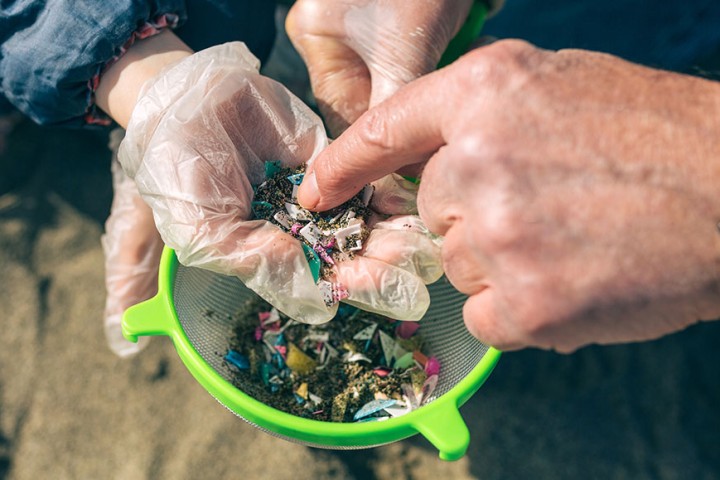Too harmful: The march of salt and plastics on world soils

There are more under-reported consequences of human activities outmatching the rhythm of Mother Nature. Such is the case, among many others, of the growing salinization and ‘plastification’ of the world’s soils.
In fact, currently it is estimated that there are more than 833 million hectares of salt-affected soils around the globe (8.7% of the planet). This implies the loss of soil’s capacity to grow food and also increasing impacts on water and the ability to filter pollution. Unsustainable human activities are exacerbating soil salinity. Excessive tillage, the over-use of fertilizers, inappropriate irrigation methods and use of poor-quality water, deforestation or the over exploitation of groundwater are the main drivers of human-induced soil salinization
Soil salinization and sodification are major soil degradation processes threatening ecosystems and are recognized as being among the most important problems at a global level for agricultural production, food security and sustainability in arid and semi-arid regions, says the UN on occasion of the 2021 World Soil Day.
Not only: salt-affected soils have serious consequences on soil functions, such as in the decrease in agricultural productivity, water quality, soil biodiversity, and soil erosion and have a decreased ability to act as a buffer and filter against pollutants.
Salt-affected soils reduce both the ability of crops to take up water and the availability of micro nutrients, and they also concentrate ions that are toxic to plants and may degrade the soil structure.
A threat to global pantry
Soil salinity is a naturally occurring phenomenon in arid environments, such as deserts, where intense evaporation and a chronic lack of water often turn the earth overly saline. Soils like these are less fertile because salt hampers plants’ natural ability to take up water from the ground, explains the UN Food and Agriculture Organization (FAO).
“But unsustainable human activities are exacerbating soil salinity. Excessive tillage, the over-use of fertilizers, inappropriate irrigation methods and use of poor-quality water, deforestation or the over exploitation of groundwater are the main drivers of human-induced soil salinization.”
The World Soil Day 2021 and its campaign “Halt soil salinization, boost soil productivity” aimed to raise awareness of the importance of maintaining healthy ecosystems and human well-being by addressing the growing challenges in soil management, fighting soil salinization, increasing soil awareness and encouraging societies to improve soil health.
According to FAO, these are, among others, the impacts of salt-affected soils:
Salt-affected soils have serious impacts on some of the ecosystem services soils usually provide, which are critical for supporting human life and biodiversity leading to an array of consequences including:
- decreased agricultural productivity, water quality, soil biodiversity, and increased soil erosion;
- decreased ability to act as a buffer and filter against contaminants;
- degraded soil structure;
- decreased functions of ecological systems such as the hydrological and nutrient cycles;
- reduced ability of crops to take up water
- reduced soil fertility and availability of micro nutrients.
Half of Uzbekistan’s soils covered by salt
The Central Asian country is doubly land-locked‚meaning it is surrounded by countries that are themselves landlocked—and more than half of Uzbekistan’s soils are salt-affected, making it extra hard to farm productively, the Food and Agriculture Organization (FAO) reports as an example.
Not only salt… also plastic
A December 2021 new report by FAO suggests that the land human beings use to grow food is contaminated with “far larger quantities of plastic pollution,” posing an even greater threat to food security, people’s health, and the environment.
The report—“Assessment of agricultural plastics and their sustainability: a call for action”—is the first global report of its kind by FAO and contains some startling numbers.
According to data collated by the UN agency’s experts:
– Agricultural value chains each year use 12.5 million tonnes of plastic products.
– A further 37.3 million tonnes are used in food packaging. The crop production and livestock sectors were found to be the largest users, accounting for 10.2 million tonnes per year collectively, followed by fisheries and aquaculture with 2.1 million tonnes, and forestry with 0.2 million tonnes.
– Asia was estimated to be the largest user of plastics in agricultural production, accounting for almost half of global usage. In the absence of viable alternatives, demand for plastic in agriculture is only set to increase.
– According to industry experts, for instance, global demand for greenhouse, mulching and silage films will increase by 50 percent, from 6.1 million tonnes in 2018 to 9.5 million tonnes in 2030.
– Such trends make it essential to balance the costs and benefits of plastic. Of increasing concern are micro plastics, which have the potential of adversely affecting human health. While there are gaps in the data, they shouldn’t be used as an excuse not to act, FAO warned.
“This report serves as a loud call to coordinated and decisive action to facilitate good management practices and curb the disastrous use of plastics across the agricultural sectors,” FAO Deputy Director-General Maria Helena Semedo said in the report’s foreword.
The report was presented today at a virtual event in conjunction with World Soil Day marked each year on 5 December.
Ubiquitous
“Plastics have become ubiquitous since their widespread introduction in the 1950s, and it is difficult today to envisage life without them.
In agriculture, plastic products greatly help productivity, according to the report.
“Mulch films, for instance, are used to cover the soil to reduce weed growth, the need for pesticides, fertilizer and irrigation; tunnel and greenhouse films and nets protect and boost plant growth, and extend cropping seasons and increase yields.”
This is also the case of “coatings on fertilizers, pesticides and seeds control the rate of release of chemicals or improve germination; tree guards protect young seedlings and saplings against damage by animals and provide a micro climate that enhances growth.”
Meanwhile, plastic products help reduce food losses and waste, and maintain its nutritional qualities throughout a myriad of value chains, thereby improving food security and reducing greenhouse gas emissions, the report explains.
Billions of tonnes of plastic not properly disposed
Of the estimated 6.3 billion tonnes of plastics produced up to 2015, almost 80% has not been disposed of properly, says FAO.
Once in the natural environment, plastics can cause harm in several ways. The effects of large plastic items on marine fauna have been well documented.
However, as these plastics begin to disintegrate and degrade, their impacts begin to be exerted at the cellular level, affecting not only individual organisms but also, potentially, entire ecosystems.
Micro plastics (plastics less than 5 mm in size) are thought to present specific risks to animal health, but recent studies have detected traces of micro plastic particles in human feces and placentas. There is also evidence of mother-to-fetus transmission of much smaller nano plastics in rats.
While most scientific research on plastics pollution has been directed at aquatic ecosystems, especially oceans, FAO experts found that agricultural soils are thought to receive far greater quantities of micro plastics.
Since 93% of global agricultural activities take place on land, there is an obvious need for further investigation in this area, concludes the report.
Need to know more?
Very little of the plastic we discard every day is recycled or incinerated in waste-to-energy facilities. Much of it ends up in landfills, where it may take up to 1,000 years to decompose, leaching potentially toxic substances into the soil and water, according to the UN Environment Program (UNEP), which warns that one third of all plastic waste ends up in soils or freshwater.
Furthermore: over 400 million tonnes of plastic are produced globally each year. It is estimated that one third of all plastic waste ends up in soils or fresh waters, according to Researchers from the Leibniz-Institute of Freshwater Ecology and Inland Fisheries (IGB).
More than marine pollution
Most of this plastic disintegrates into particles smaller than five millimeters, referred to as micro plastics, and breaks down further into nano particles, which are less than 0.1 micrometer in size.
“In fact, terrestrial micro plastic pollution is much higher than marine microplastic pollution – an estimate of four to 23 times more, depending on the environment. Sewage, for example, is an important factor in the distribution of micro plastics.”
Also that “80% to 90% of the particles contained in sewage, such as from garment fibers, persist in the sludge. Sewage sludge is then often applied to fields as fertilizer, meaning that several thousand tonnes of micro plastics end up in our soils each year.”

